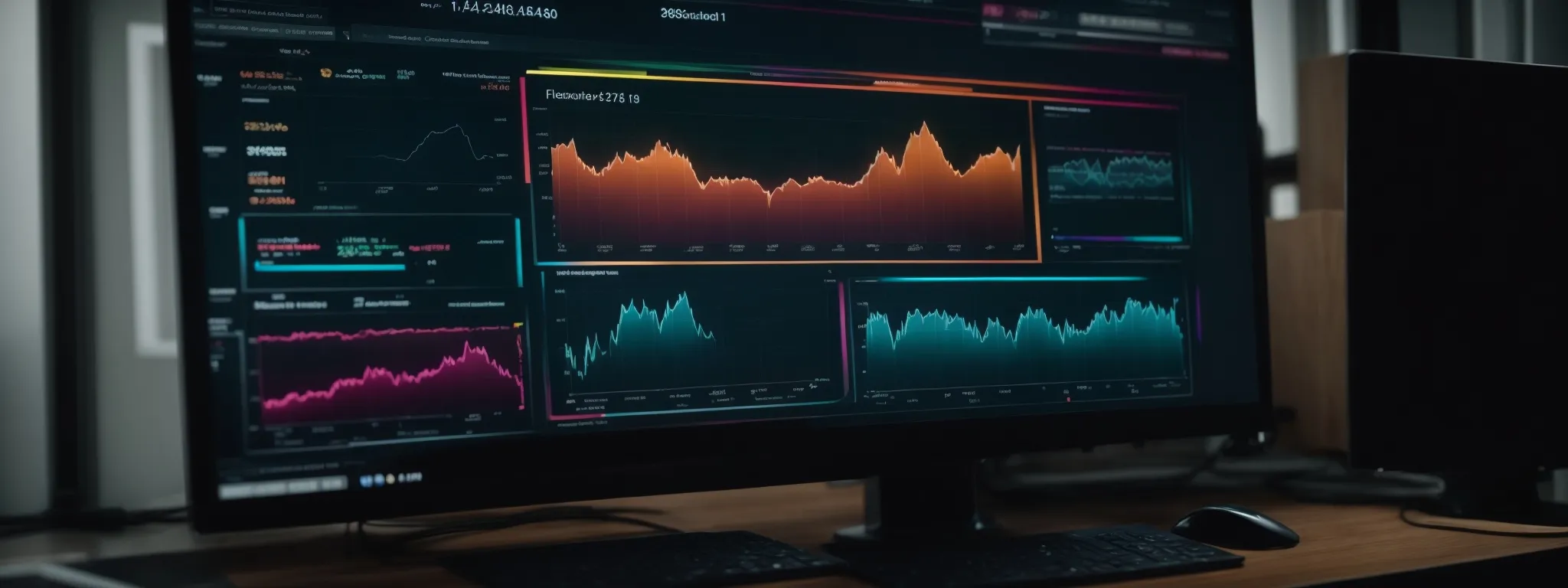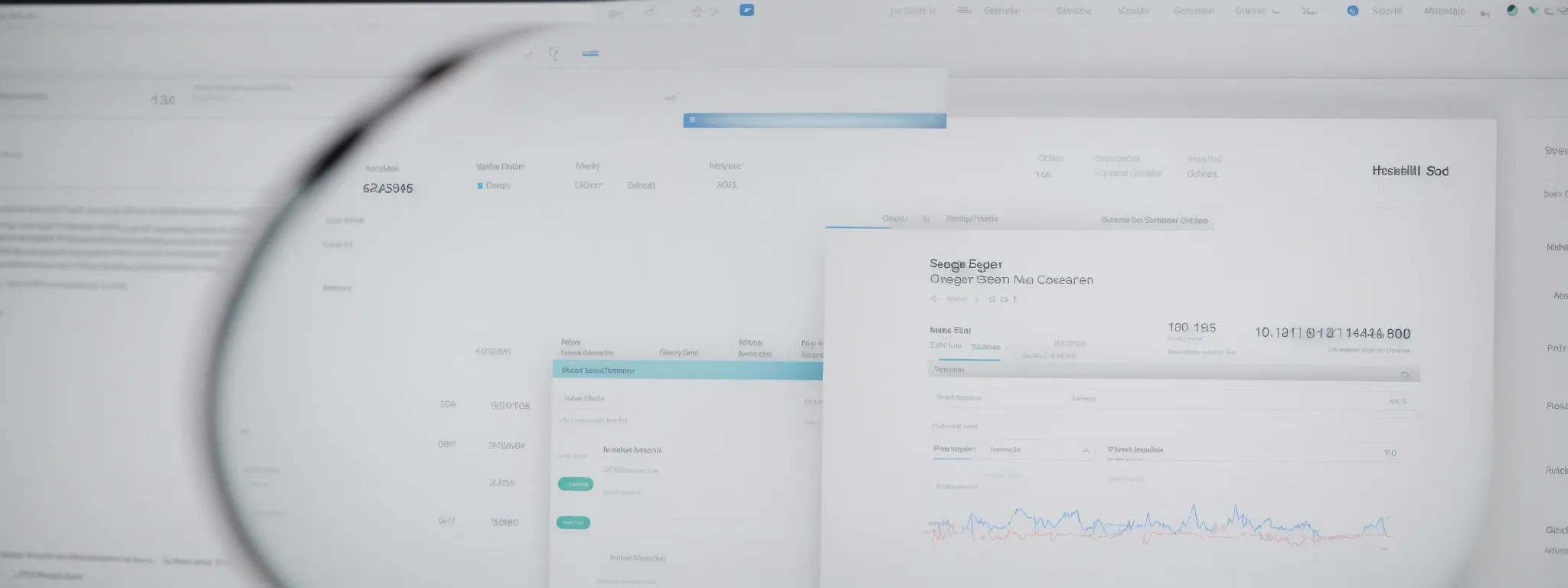Keywords Unleashed: SEO Copy Enhancement
Mastering SEO Copywriting: Keywords Unleashed In the realm of digital marketing, mastering SEO copywriting is tantamount to unlocking a treasure chest bursting with potential. With the surge […]
Mastering SEO Copywriting: Keywords Unleashed
In the realm of digital marketing, mastering SEO copywriting is tantamount to unlocking a treasure chest bursting with potential.
With the surge in online competition, the strategic deployment of keywords within content has become critical in distinguishing a brand and elevating its search engine ranking.
LinkGraph’s extensive SEO services offer a comprehensive guide to harnessing the power of keywords, ensuring that content not only resonates with its intended audience but also captivates the ever-evolving algorithms of search engines.
By integrating expertly researched search terms, optimizing SEO titles, and employing savvy meta tag tactics, businesses can empower their narratives to soar beyond ordinary horizons.
Keep reading to immerse yourself in the transformative journey of SEO copywriting and witness the unleashing of your brand’s full potential through the precision of keyword mastery.
Key Takeaways
- Effective SEO Copywriting Requires Strategic Keyword Placement and Understanding of Search Intent
- LinkGraph’s SEO Services Include Meticulous Competitor Keyword Analysis and Tailored Content Strategies
- Continuous Keyword Performance Assessment and Adaptation Are Crucial for Maintaining Search Relevance
- Advanced SEO Techniques Like the Use of LSI and Semantic Keywords Enhance Content Depth and Context
- Evolving SEO Trends Such as Voice Search and AI Necessitate Ongoing Research and Refinement of Keyword Strategies
Understanding the Power of Keywords in SEO

The quintessence of search engine optimization often lies in the strategic placement and choice of keywords.
Mastering SEO copywriting demands more than a superficial engagement with these linguistic touchpoints; it necessitates a deep comprehension of the nuances that connect keywords to search engine success.
One begins by grasping the basics of keyword relevance, acknowledging that every word carries the weight of potential visibility.
Further, industry experts identify a gamut of keyword types, each serving a unique purpose in the broader SEO content strategy.
Most critically, a keen sense of recognition is required to decode the user intent behind each search query.
This discernment serves as the compass for crafting content that aligns with the searcher’s needs, thereby guiding them effortlessly towards the information or services they seek, such as those offered by LinkGraph’s SEO services.
By unraveling the significance of keyword intricacies, businesses unlock the doorway to optimize their web presence and elevate their brand in the digital marketplace.
Grasping the Basics of Keyword Relevance
Securing a robust online presence begins with understanding the symbiotic relationship between keywords and search relevance. A marketer must discern the optimal language that resonates with the target audience, integrating keywords seamlessly to enhance the copy’s visibility on search engines.
Crucially, the essence of keyword relevance is not rooted solely in frequency, but in the quality and context of usage. LinkGraph’s SEO services emphasize precision and relevance, tailoring an SEO content strategy to match user intent with keyword optimization, pushing the boundaries of search engine performance.
Identifying the Different Types of Keywords
Within the realm of SEO, keywords are categorized to meet diverse objectives and audiences. Core keywords often encapsulate the main concept of a brand or product, serving as the bedrock to any SEO strategy.
Once foundational keywords are established, the granulation into long-tail keywords occurs: These longer phrases, though lower in search volume, boast higher conversion rates owing to their specificity and alignment with precise user queries:
- Core Keywords: Represent the essence of a brand or service.
- LSI Keywords: Enhance contextuality and complement core terms.
- Long-Tail Keywords: Target precise user intentions with specificity.
Additionally, semantic keywords, or LSI (Latent Semantic Indexing) keywords, emerge as vital elements that ensure content comprehensiveness and bolster relevance signals to search engines, aiding in the sophisticated matching of search terms to the user’s intent.
Recognizing the User Intent Behind Searches
To discern the subtle yet vital aspect of user intent behind searches, professionals at LinkGraph employ a suite of meticulous analytic tools and frameworks, including the advanced capabilities of their SearchAtlas SEO software. With this sophisticated approach, the intricacies of search intent are laid bare, affording marketers the insights to tailor their site content with precision, thus resonating with the seekers behind every search query.
Aligning SEO strategies with the user’s quest for answers, products, or services, naturally cultivates an enhanced user experience that fosters loyalty and engagement. LinkGraph’s SEO services excel in decoding this intent, ensuring that every page title, alt text, and piece of body copy serves as a beacon for users, guiding them to the information they seek, paving the way for improved search engine rankings and conversion rates.
Crafting a Winning Keyword Strategy

Embarking on the journey of SEO copywriting, one must navigate through the ecosystem of keywords with both tact and acuity.
Prior to plunging into the tactical execution, it’s imperative for one to establish an intimate understanding of their target audience.
This preparatory step is non-negotiable and serves as the cornerstone of a full-bodied SEO strategy.
Subsequently, a meticulous analysis of competitor keyword usage lays the foundation for competitive edge, revealing gaps and opportunities.
The culmination of this preparatory phase is the creation of a comprehensive keyword list, a robust array that is both flexible and targeted, setting the stage for SEO initiatives that yield measurable results and capture the very essence of search relevance.
Establishing Your Target Audience
The initial step in weaving an effective SEO tapestry involves a laser focus on understanding the demographics, psychographics, and behavioral tendencies of the intended audience. LinkGraph’s white label SEO services provide businesses with the clarity needed to shape a narrative that resonates, ensuring that content creation starts on the bedrock of consumer insights.
Armed with data-driven personas, businesses can fine-tune their message, ensuring that every keyword and phrase caters to the precise needs and search behaviors of their desired clientele. This alignment not only enhances the relevance of the content but also amplifies the likelihood of engendering genuine engagement and higher conversion rates.
Analyzing Competitor Keyword Usage
Meticulous analysis of competitor keyword usage equips marketers with actionable intelligence, illuminating the strategic moves of competitors within the SEO playing field. Armed with this knowledge, LinkGraph’s SEO experts refine clients’ SEO content strategies, tactically positioning their brand to capitalize on opportunities overlooked or underemphasized by others in the industry.
Through astute competitor analysis, LinkGraph distills valuable insights, tracing the keyword patterns that drive traffic to rival sites. This intelligence informs the optimization of clients’ web content, ensuring their presence not only matches but surpasses competitors on the search engine result pages (SERPs), thus claiming a vantage point in the eyes of the target audience.
Creating a Comprehensive Keyword List
Creating a comprehensive keyword list is akin to assembling a master key for unlocking the potential of a website. LinkGraph’s expertise in harnessing the power of meticulous keyword research culminates in a curated array that spans across various searcher intents, providing a foundation for strategic content dissemination and optimization.
The process involves employing sophisticated keyword research tools to filter and pinpoint terms that carry significant search volume, balanced with a keen assessment of keyword difficulty. This strategic compilation forms a cornerstone for LinkGraph’s tailored SEO services, ensuring clients’ site content is primed to capture the attention of search engines and visitors alike.
Integrating Keywords Into Your Content Seamlessly

As the ley lines of Search Engine Optimization draw experts and novices alike towards SEO copywriting mastery, the cornerstone of this craft hinges on the judicious use of keywords.
It’s not merely about peppering web copy with SEO keywords—it’s more akin to a meticulous art, where affinity for one’s brand is expressed through the content’s natural ebb and flow.
Balancing the elements of keyword density with readability, placing keywords with a tactical aim, and steering clear of the detrimental practice of keyword stuffing, constitute the nuanced approaches that comprise professional, seamless integration.
Proficiency in these techniques exemplifies how LinkGraph excels in elevating site content to the pinnacle of search engine visibility, without sacrificing the user experience or the narrative’s authenticity.
Balancing Keyword Density and Readability
Achieving equilibrium between keyword density and readability requires a deft touch, considering both the algorithmic preferences of search engines and the expectations of readers. Striking a balance is critical: too many keywords can disrupt the readability and flow, diminishing the user experience, while too few may render the content invisible to search queries.
LinkGraph’s SEO specialists optimize content by integrating keywords organically, ensuring that every web page meets the delicate threshold where SEO effectiveness converges with clear, engaging language. This approach results in quality content that search engines favor and readers value, thus fulfilling dual objectives with skillful precision:
| SEO Goal | LinkGraph’s Strategy | Outcome |
|---|---|---|
| Effective Keyword Integration | Seamless insertion of relevant keywords | Enhanced Visibility on SERPs |
| Improved User Experience | Maintaining readability and engagement | Increased Reader Retention and Conversion |
Strategically Placing Keywords in Your Text
Strategic placement of keywords transcends mere inclusion; it requires an understanding of their optimal positioning within the copy to maximize SEO impact. For instance, LinkGraph’s on-page SEO services focus on distributing keywords throughout strategic locations such as the title tag, headings, and the initial paragraphs of a web page to capture the essence of the content and cast a wider net for search engines.
Integrating keywords into the meta descriptions and alt text of images serves a dual purpose: not only does it further inform search engines about the page’s content, but it also enhances visibility in image search results, leading to a more comprehensive SEO approach. LinkGraph’s experts leverage this tactic effectively, facilitating an increase in organic traffic and an improved overall search presence:
| Strategic Position | LinkGraph’s SEO Practice | Impact on SEO |
|---|---|---|
| Title Tag and Headings | Embed targeted keywords | Boost relevance for search queries |
| Meta Descriptions and Alt Text | Incorporate descriptive keywords | Enhance search visibility and image indexing |
Avoiding the Pitfalls of Keyword Stuffing
The artistry of SEO copywriting does not indulge in the excess but celebrates the mindful placement of keywords that respects both readability and relevance. Avoiding the overzealous infusion of terms, known as keyword stuffing, is crucial: it protects the narrative’s integrity and preserves the intended user experience.
LinkGraph’s seasoned SEO copywriters are attuned to the delicate balance required, crafting content where keywords support rather than overwhelm the message. They recognize that the strategic use of keywords should always serve to enhance, not detract from, the value provided to the reader and the perceived quality by the search engines.
- Understand the threshold where keyword usage benefits SEO without undermining the content’s quality.
- Employ keywords to support the narrative, ensuring they integrate fluidly within the text.
- Maintain reader engagement by prioritizing content value and relevance over keyword quantity.
The Art of Writing SEO-Friendly Titles

At the heart of SEO copywriting lies the challenge of crafting titles that beckon to both search engines and humans.
The artistry involved in selecting title structures and phrasing piques curiosity, drawing readers into the textual journey that awaits.
Within this fusion of creativity and strategy, the intelligent application of primary keywords becomes a linchpin to success, influencing not just search engine relevancy but also click-through rates.
Navigating through these facets with finesse, LinkGraph’s seasoned experts elevate titles to become the compelling entry points that lead to engagement and conversion.
Identifying Compelling Title Structures
Identifying compelling title structures is not about mere aesthetics; it’s a strategic exercise that influences user engagement and search performance. A title acts as a promise to the reader, hinting at the value enclosed within the web page while embedding the target keyword in a context that is both informative and inviting.
LinkGraph’s SEO specialists recognize the profound impact of well-crafted titles. They employ a data-driven approach to ascertain the most efficacious title constructions, ensuring that every page title serves as a beacon, guiding the target audience from the SERPs to the website with the promise of fulfilling their search intent.
Incorporating Primary Keywords Effectively
Incorporating primary keywords into a title necessitates a measured approach where precision meets creativity. Professionals at LinkGraph deftly interweave these focal words into titles, ensuring they not only reflect the content’s essence but also resonate with the target audience’s search queries.
The strategic placement of primary keywords at the beginning of a title can significantly amplify the content’s visibility and appeal. Expert practitioners understand that this placement can heighten a title’s relevance in the eyes of a search engine and also grab the attention of users as they scan through a search engine results page:
| Title Element | Keyword Strategy | Expected Impact |
|---|---|---|
| Beginning of Title | Position primary keyword prominently | Enhance visibility and click-through rates |
| Contextual Relevance | Match keywords with user intent and content theme | Improve search engine ranking and user engagement |
Optimizing Titles for Click-Through Rates
Optimizing titles for click-through rates (CTRs) transcends keyword placement, crystallizing the user’s curiosity into a decisive action. A compelling title exudes a magnetic pull, encouraging the searcher to choose one particular search result over all others; it’s a pivotal element that directly influences the performance metrics of a given web page.
The collaboration of SEO savviness and marketing acumen places LinkGraph at the forefront of crafting titles that are irresistible to click. They combine persuasive language with target keyword optimization, creating titles that tap into the searcher’s psyche, promising and delivering exactly what they seek:
- Invoke curiosity without sacrificing clarity or relevance.
- Employ actionable language that spurs the reader to engage.
- Strategically include powerful modifiers that align with the searcher’s intent.
By refining this innovative yet methodical approach to title optimization, LinkGraph advances their clients’ content strategy, nurturing the delicate balance between enticing page titles and maximizing CTRs. The impact is clear: well-optimized titles not only foster a higher rank in search results but amplify visitor engagement, driving business growth and online success.
Meta Descriptions That Boost SERP CTR

In the arena of SEO copywriting, the meta description stands as a concise yet potent ally, wielding the power to influence click-through rates on search engine results pages.
As digital gateways offering a glimpse into the heart of the web page’s content, these snippets carry the onus of enticing the searcher with a compelling reason to click through.
They should encapsulate the essence of the content while incorporating a clear call-to-action, embedding target keywords with strategic prudence, and maintaining brevity aligned with magnetic appeal.
Expertly crafting meta descriptions is a testament to one’s mastery over SEO copywriting—an essential skill set offered through LinkGraph’s comprehensive suite of SEO services.
Writing Meta Descriptions With a Call-to-Action
Masterful execution of meta descriptions presents an inviting narrative that compels action and sparks curiosity. LinkGraph harnesses this opportunity by infusing each meta description with a clear, compelling call-to-action that urges the searcher to proceed: Click here, Learn more, Discover how—these promptings serve as the critical bridging point between interest and interaction.
The magic of a well-crafted call-to-action within a meta description cannot be overstated; it translates the user’s passive scanning into active engagement. As LinkGraph’s seasoned professionals weave CTA’s into the meta narrative, they ensure each description is not only aligned with the page’s content but also poised to elevate click-through rates:
- Craft a succinct meta description that encapsulates the page’s essence.
- Embed a compelling call-to-action that directs the searcher’s next move.
- Strategically integrate target keywords to underscore the meta’s relevance.
Including Target Keywords in Your Snippets
Including target keywords in meta description snippets operates as a strategic imperative, grounding the essence of a web page within the context of searcher needs. By embedding these targeted terms, LinkGraph ensures the meta descriptions work effectively as signals to search engines, delineating content relevance and enhancing the likelihood of climbing SERP rankings.
LinkGraph’s meticulous integration of target keywords into snippets not only serves search engines but also addresses the searcher’s desire for immediate relevance. As professionals craft the brief yet impactful meta descriptions, every word is chosen with care, ensuring snippets serve as the powerful connection between user query and content fulfillment, nudging SERP click-through rates upward.
Keeping Meta Descriptions Concise and Appealing
The precision of a masterfully written meta description lies in its brevity and allure, sparking interest without overloading the reader with details. LinkGraph’s expertise shines in distilling the quintessential appeal of a webpage into fewer than 160 characters, striking a balance that piques interest and sustains SERP rankings through tightly woven, keyword-rich narratives.
LinkGraph’s professionals create these succinct synopses, ensuring each one is compelling enough to stand out amidst the sea of search results. Their skillful crafting of meta descriptions involves deliberate word choice, compelling visitors to act, while maintaining an air of intrigue that leaves readers eager to explore the content in full.
Efficient Use of Headers to Structure SEO Content

Crafting content that is both search engine-friendly and user-centric is a nuanced endeavor, requiring more than mere wordplay—it demands structure, hierarchy, and strategic keyword inclusion.
The intelligent application of header tags such as H1, H2, and H3 is not merely a nod to aesthetics; it is a critical component of SEO copywriting that aids search algorithms and readers in parsing content efficiently.
Experts at LinkGraph understand the importance of distinguishing between the different levels of header tags, ensuring focus keywords are positioned to garner maximum impact.
By meticulously outlining content using headers, they enhance the navigation experience, leading to content that is as digestible as it is discoverable—each section meticulously crafted to unite clarity with SEO precision.
Distinguishing Between H1, H2, and H3 Tags
In the layered landscape of SEO content, the discernment between H1, H2, and H3 tags is tantamount to the creation of a clear, hierarchical outline for both search engines and users. The H1 tag heralds the primary topic of a page hence it is typically reserved for the main title, sharply focusing on the central theme and primary keywords.
Delineation extends to H2s and H3s, which serve as subheadings to break down content into manageable subsections and supporting points, respectively. These tags not only organize the content logically but also provide multiple opportunities to include secondary keywords in a manner that naturally enhances the SEO structure:
| Header Tag | Purpose in SEO | Keyword Integration |
|---|---|---|
| H1 | Signify main title/topic of the page | Primary keywords focused |
| H2 | Introduce subsections/themes | Secondary and semantic keywords |
| H3 | Detail supporting points/ideas | Long-tail and niche keywords |
LinkGraph’s SEO experts utilize H1 to H3 tags not just for their structural benefits but also to enhance the on-page SEO services they provide, weaving a web of clarity for spiders and readers alike. This practice affords the content a competitive edge in SERPs, ensuring that each header tag works diligently to organize and emphasize the SEO-relevant elements within the web copy.
Placing Focus Keywords in Header Tags
Strategically embedding focus keywords within header tags elevates the SEO strength of any given web page, signaling to search engines the salient points of the content. LinkGraph’s adept SEO specialists prioritize these focus keywords within the H1, as it encapsulates the page’s principal topic, firmly anchoring the content in relevancy and authority.
The effective placement of focus keywords extends into H2 and H3 tags, which organize the content’s subsections and supporting details. LinkGraph’s calculated approach to this task ensures these keywords are distributed judiciously, enhancing the content’s searchability without losing coherence or reader engagement:
- H1 tags receive the primary focus keyword, setting the tone for the entire page.
- H2 tags house secondary keywords, making subsections easier to locate and understand both for users and search algorithms.
- H3 tags incorporate additional related terms, attracting a wider array of search queries.
Outlining Content Using Headers for Easy Navigation
Proper outlining of content using headers is integral to facilitating easy navigation for visitors. LinkGraph’s approach to SEO emphasizes this, creating structured pathways through H1 to H3 tags that guide users through the web page’s terrain with ease and clarity: It’s a map that leads visitors from point to point without confusion or frustration.
- H1 tags mark the starting point, signaling the overarching topic.
- H2 tags act as signposts to major sections, directing the user flow.
- H3 tags delve into specifics, offering detailed explorations within each section.
By diligently structuring content in this hierarchical manner, LinkGraph ensures that every header serves its navigational purpose. This strategy not only caters to the user’s demand for quick information retrieval but also aligns with SEO best practices that enhance the readability for search engines, optimizing the web page’s findability in a seamless synergy of form and function.
Optimizing Images With Keywords for Better SEO

In the digital tapestry of SEO copywriting, images are far more than mere visual garnishes; they are pivotal assets capable of elevating a brand’s narrative through strategic keyword integration.
A picture speaks volumes not only to the user but also to the search engine algorithms that parse visual content for its relevancy and context.
In this section, we explore the finesse required to write descriptive alt text, the importance of keyword-enriched image file names, and how adeptly optimizing images secures a perceptible uplift in search engine rankings.
Each image optimized is a step towards a more cohesive SEO strategy, masterfully intertwining the visual with the textual to deliver a multi-dimensional user experience.
Writing Descriptive Alt Text for Images
Composing alt text for images is a critical exercise in detailing, which affords search engine crawlers precise insights into the pictorial content. LinkGraph’s adept SEO strategists deploy keywords within alt text to enhance image discoverability, ensuring a seamless integration that bolsters the web page’s overall SEO footprint.
By enriching alt text with descriptive, keyword-focused narratives, LinkGraph ensures images contribute to the thematic strength of the site content. This strategic inclusion acts as a silent yet powerful communicator with search engines, directly facilitating an increase in the web page’s relevance and visibility within image search results.
Using Keywords in Image File Names
LinkGraph’s meticulous approach to SEO extends to the often-overlooked detail of image file names. Embedding keywords directly within file names provides search engines with another layer of context, elevating the relevance of visuals and intertwining them with the site’s overall keyword strategy.
Professionals ensure that each image file name reflects the content it complements, infusing it with targeted keywords that enhance a page’s SEO narrative. This practice not only simplifies the indexing process for search algorithms but also fortifies the thematic consistency of the visual elements on a client’s web page.
Understanding the Impact of Image SEO on Rankings
Image SEO stands as an integral component of an overarching content strategy, influencing a site’s visibility and ranking within search engine results. The strategic infusion of relevant keywords into image elements, like file names and alt attributes, signals thematic context to search algorithms, bolstering the textual content with a layer of visual relevance that contributes to ranking efficacy.
Professionals at LinkGraph leverage image SEO as a pivotal facet of comprehensive optimization efforts, recognizing that images, when optimized correctly, serve as gateways to improve a website’s search presence. Skillful alignment of visual content with the semantic core of site copy can effectively enhance a website’s rank, ensuring it reaches a broader target audience while augmenting user engagement.
The Role of Long-Tail Keywords in Niche Targeting

In the fine-grained world of SEO copywriting, the astute deployment of long-tail keywords has emerged as a force multiplier for brands aiming to dominate the niche corners of the digital market.
Beyond the allure of high-volume search terms, these descriptive and often specific phrases hold the key to connecting with a sharply targeted audience—a demographic that may be smaller in size but unparalleled in conversion potential.
Mastering the trifecta of identifying niche-specific long-tail keywords, crafting content that resonates with these searches, and accurately measuring the success of these strategies, positions businesses to reap the benefits of refined targeting and enhanced online presence.
Identifying Niche-Specific Long-Tail Keywords
Uncovering niche-specific long-tail keywords is an investigative pursuit, deftly honed by the experts at LinkGraph. It begins with dissecting customer queries and feedback, scanning social forums, and leveraging advanced keyword research tools, offering clear insights into the specific phrases used by the target demographic.
The precision with which niche-specific long-tail keywords are chosen dictates the effectiveness of tailoring site content to meet the nuanced demands of a segment. These Meticulously Selected Phrases encapsulate the searcher’s exact problem or desire, bridging the gap between brand offerings and the audience’s specific needs:
- Scrutinize customer communications for recurring themes and vocabulary.
- Monitor niche forums and social media platforms to capture vernacular trends.
- Deploy cutting-edge keyword research tools to validate search volume and relevance.
Such targeted keyword strategies not only ensure heightened visibility within a finely tuned market space but also amplify the probability of attaining a higher conversion rate, a testament to LinkGraph’s nuanced approach to SEO copywriting.
Crafting Content to Rank for Long-Tail Searches
Crafting content that ranks effectively for long-tail searches involves a dedicated focus on contextual relevance and user experience. Each piece of content must speak directly to the nuanced needs and questions of the target audience, embedding long-tail keywords with a precision that feels natural and provides genuine value.
Engaging content tailored for long-tail keyword ranking is not merely sprinkled with key phrases but is built around them, designing a narrative that resonates deeply with the searcher’s intent. This approach hinges on understanding the specific nuances of each long-tail keyword and shaping the story in a way that the keyword acts as the main thread, seamlessly interconnected with informative and valuable insights:
- Analyze the search intent behind long-tail queries to align content with user expectations.
- Integrate long-tail keywords in a manner that enhances readability while preserving keyword importance.
- Offer in-depth information that addresses the broader context surrounding the long-tail terms.
Measuring the Effectiveness of Long-Tail Keyword Strategies
Measuring the effectiveness of long-tail keyword strategies warrants a detailed examination of engagement metrics and conversion data. LinkGraph’s Suite of Analytics Tools provides clients with the ability to track the visibility of long-tail keywords, monitor click-through rates, and analyze the nature of traffic that converts into valuable customer actions.
Through rigorous data analysis, LinkGraph identifies trends and insights that inform further strategic refinement. Such quantitative assessments enable continuous optimization of long-tail SEO tactics, ensuring that businesses not only reach their target audience with precision but also achieve their desired outcome in terms of conversions and ROI.
Revamping Your Content With Keyword Optimization

In the intricate dance of SEO copywriting, the continual refinement of keywords within content stands paramount.
As the online landscape evolves, so too must the language that guides users and algorithms alike to the heart of a website’s offering.
Professionals are thus tasked with the delicate endeavor of rejuvenating outdated material, employing analytics as a compass to navigate the performance of existing keywords, and adapting content to mirror the ebb and flow of keyword trends.
This ceaseless cycle of improvement ensures that each web page is not only relevant but resonates with the ever-changing symphony of search engine criteria.
Updating Old Content With Fresh Keywords
Revitalizing legacy content with contemporary keywords is a pivotal move for brands aiming to maintain a stronghold in their digital domain. LinkGraph’s expertise shines in identifying underperforming pages and infusing them with updated search keywords, effectively breathing new life into existing content and bolstering its relevance for modern search behaviors.
LinkGraph’s diligent approach ensures the refreshed content transcends mere trend chasing; it involves a strategic overhaul that aligns with ongoing changes in user search patterns and preferences. This methodical update elevates the content’s viability, ensuring enduring visibility and engagement within the fluid search landscape.
Using Analytics to Determine Keyword Performance
LinkGraph’s tactics for keyword performance assessment hinge on a suite of advanced analytics tools that unmask the efficacy of SEO efforts. These tools supply a stream of data insights, allowing examination of keyword rankings, search volumes, and website traffic driven by individual keywords.
Operating with precision, LinkGraph employs analytics to refine an SEO content strategy, scrutinizing how well keywords perform and identifying which ones merit optimization or replacement. This measured analysis equips clients with the intelligence needed to stay ahead in the dynamic search engine environment:
| Analytics Measure | LinkGraph’s Assessment Approach | Optimization Action |
|---|---|---|
| Keyword Rankings | Evaluate current positions in SERPs | Adjust or enhance keyword targeting |
| Search Volumes | Analyze search frequency | Focus on high-potential keywords |
| Website Traffic | Track visitor numbers and behavior | Refine content for better engagement |
Continuously Improving Content Based on Keyword Trends
In the dynamic landscape of SEO, LinkGraph champions the practice of perpetual content enhancement, adapting to keyword trends with agility. Leveraging insights gleaned from search patterns, they ensure clients’ content remains at the forefront of relevance, responding to evolving user preferences and algorithm updates with strategic keyword recalibration.
This commitment to continuous optimization is emblematic of a forward-thinking approach, one which champions adaptability in an ever-shifting digital arena. By anticipating shifts in search behaviors, LinkGraph positions clients’ content for sustained engagement and authority, safeguarding their competitive edge:
| Keyword Trend | LinkGraph’s Adaptation |
|---|---|
| Rising Search Terms | Swift inclusion in content updates |
| Algorithmic Shifts | Content and keyword strategy recalibration |
| User Behavior Changes | Responsive adjustments to maintain engagement |
Advanced Techniques: LSI Keywords and Semantic Search

In the realm of SEO copywriting, the capacity to elevate content beyond the ordinary pivots on a nuanced grasp of LSI (Latent Semantic Indexing) keywords and semantic search strategies.
As architects of text, copywriters are expected to harness these advanced techniques to construct a robust framework of relevance and context around the primary keywords.
Shedding light on these sophisticated mechanisms reveals the importance of LSI keywords in refining topic signals and the undeniable benefits of expanding content relevance through semantic richness.
Accordingly, professionals adept at leveraging innovative tools uncover chances for integrating LSI and semantic keywords, effectively increasing the resonance and reach of their composed narratives within the digital marketplace.
Explaining LSI Keywords and Their Importance
Latent Semantic Indexing (LSI) keywords have emerged as critical elements in SEO copywriting, providing search engines with robust contextual signals that enhance content relevance. These terms, semantically related to primary keywords, assist search engines in deciphering the overarching themes and nuances within web copy, elevating the content’s comprehensiveness and depth.
The incorporation of LSI keywords dovetails with the strategic imperatives of SEO, as it not only enriches the content for algorithms but also enhances the user experience by aligning closely with the varied expressions of searcher intent. Professionals at LinkGraph recognize the importance of LSI terms, expertly weaving them into content to bolster its authority and relevance in a competitive digital ecosystem.
Expanding Content Relevance Through Semantic Keywords
Expanding content relevance with strategic use of semantic keywords allows LinkGraph’s experts to create layers of meaning that resonate with both the user and the underlying search algorithms. This approach goes beyond singular keywords, delving into the nuances of language as it unfolds naturally, embedding themes and concepts related to the core topic in a manner that mirrors organic human dialogue.
Integrating semantic keywords effectively elevates the depth of content, positioning it to address a broader range of related search queries. Professionals at LinkGraph skillfully enhance the semantic field around primary keywords, thus enriching the content’s appeal and enabling it to perform robustly across a spectrum of search intentions.
Tools for Finding LSI and Semantic Keyword Opportunities
In the rapidly evolving sphere of SEO, identifying LSI and semantic keyword opportunities is made possible through innovative tools such as LinkGraph’s SearchAtlas SEO software. This platform aids professionals in discovering a profound array of related keywords, which ensures the content they craft is not only rich in context but also encircles the varied linguistic expressions used by the target audience in their online searches.
Utilizing such advanced SEO tools enables LinkGraph’s experts to distill and expand upon the semantic core of their client’s content. The insights gained from the software contribute significantly to crafting a narrative that aligns seamlessly with search algorithms, elevating the content’s discoverability while enriching the reader’s journey through a more intuitive, context-aware browsing experience.
Measuring the Impact of Your Keyword Strategy

In the intricate arena of SEO copywriting, the efficacy of a keyword strategy is not assessed by intuition but by precise metrics that quantify success.
A business’s online dominance is largely predicated on the visibility and potency of its targeted keywords.
Thus, tracking these metrics—the rankings of keywords, the influx of organic search traffic they procure, and the subsequent shifts in strategy they necessitate—becomes paramount.
It is this ongoing analysis and tactical adaptation that fortifies a keyword strategy’s relevance and ensures it yields the desired impact on search engine landscapes.
Tracking Keyword Rankings and Their Progress
LinkGraph’s approach to mastering SEO copywriting includes a diligent focus on monitoring keyword rankings and mapping their trajectory. The firm utilizes cutting-edge tools to track the ascent or descent of keywords on search engine result pages, providing clients with real-time insights into the performance of their chosen terms.
In this vigilant tracking process, LinkGraph’s experts not only note fluctuations in rankings but also decipher the underlying factors contributing to these movements. This ongoing analysis forms a critical part of their SEO service, empowering clients to make informed adjustments to their keyword strategy and bolstering their web content’s effectiveness in the digital landscape.
Analyzing Organic Search Traffic
An in-depth analysis of organic search traffic is indispensable for understanding the true value keywords bring to a brand’s digital presence. By gauging the volume, quality, and behavior of visitors who arrive via search engines, LinkGraph can precisely attribute successes and opportunities for improvement to specific SEO tactics.
This level of scrutiny allows professionals to fine-tune their keyword strategies, emphasizing those that attract targeted, convertible traffic: the lifeblood of online business. With organic traffic as a key performance indicator, LinkGraph’s expertise ensures clients’ SEO investments are data-backed, optimizing for increased visibility and conversion success:
- Volume of organic traffic provides insight into keyword efficacy.
- Quality of traffic indicates alignment with audience intent.
- Visitor behavior highlights content engagement and potential for conversions.
Adjusting Your Strategy Based on Performance Data
Integrating Performance Data Into SEO Strategy is pivotal, and at LinkGraph, this translates into a proactive recalibration of tactics. As performance metrics reveal the nuances of keyword impact, the company arranges for nimble pivots in strategy, ensuring that clients’ digital content remains in lockstep with observable trends and user engagement.
LinkGraph champions a strategic realignment process where performance analytics guide content enhancement, not as a one-time adjustment, but as a regular practice. The firm’s commitment to responsiveness allows for the optimization of keyword strategies that continually resonate with the dynamic search landscape, thereby driving sustained search performance and business growth.
Beyond Basics: The Future of Keywords in SEO Copywriting

The digital landscape is ever-evolving, and as we venture into the future, the role of keywords in SEO copywriting continues to transform and expand.
Marketers and SEO copywriters are now tasked with adapting to emerging trends, such as voice search optimization and the incorporation of conversational keywords, while also acknowledging the profound impact of artificial intelligence (AI) in reshaping keyword strategies.
In addition, the unending quest for relevance amidst changing search engine algorithms necessitates a commitment to ongoing keyword research, ensuring content remains pertinent and powerful.
With these developments, LinkGraph’s steadfast approach to search engine optimization prepares clients for a future where mastering keywords is synonymous with digital success.
Adapting to Voice Search and Conversational Keywords
As voice search technology burgeons, SEO copywriting must pivot towards a more natural and conversational tone to align with the spoken queries of users. Professionals at LinkGraph have recognized this shift, adapting their keyword strategies to include long-tail phrases that mirror the natural language of voice search users, thus ensuring content relevance in this auditory-driven landscape.
The rise of conversational keywords signifies a new dawn in SEO: a landscape where queries resemble dialogues rather than disjointed terms. LinkGraph’s experts are crafting content imbued with these colloquial keywords, optimizing it to respond adeptly to the casual tone inherent in voice-activated searches, seamlessly connecting users to the information they seek:
| SEO Trend | Impact on Keywords | LinkGraph’s Approach |
|---|---|---|
| Voice Search Optimization | Preference for natural, long-tail phrases | Incorporating conversational tone and language |
| Conversational Keywords | Shift to casual, dialogue-like queries | Creating content that reflects natural speech patterns |
Understanding AI’s Role in Keyword Evolution
The integration of artificial intelligence (AI) into keyword strategy revolutionizes the way SEO experts perceive and utilize keywords. AI algorithms are capable of identifying patterns and predicting trends in keyword usage, enabling a predictive approach to SEO copywriting that anticipates user behavior and search engine developments.
With AI’s dynamic analysis, the scope of keyword optimization is broadened, as it allows for real-time adaptations to emerging market changes. This adaptive capability ushers in a new era of SEO, where keyword strategies are not static but evolve fluidly as AI continues to refine the understanding of content relevance and searcher intent.
| AI Functionality | Impact on SEO Copywriting | LinkGraph’s Utilization |
|---|---|---|
| Pattern Recognition | Anticipates user search trends | Incorporates predictive keyword strategies |
| Real-time Analysis | Enables immediate adaptations to market changes | Employs flexible and responsive keyword placement |
Staying Ahead of the Curve With Ongoing Keyword Research
To maintain a competitive edge in SEO copywriting, ongoing keyword research is indispensable. LinkGraph’s comprehensive SEO services accentuate the importance of continually discovering fresh, relevant keywords to ensure client content aligns adeptly with shifting market dynamics and evolving user search patterns.
LinkGraph’s SEO specialists persistently track emerging trends and algorithm updates to refine and expand keyword portfolios. This proactive approach keeps web content not only current but also poised to effectively cater to the nuanced and ever-changing interests of a diverse online audience.
Conclusion
Mastering SEO copywriting through strategic keyword usage is crucial for amplifying a brand’s online visibility and engagement.
By understanding the significance of keyword relevance and incorporating a mix of core, LSI, and long-tail keywords, marketers can finely tune their content to user intent, enhancing search rankings.
Effective SEO copywriting involves not only keyword integration but also a balance of readability and keyword density, avoiding tactics like keyword stuffing.
Titles, meta descriptions, headers, and image alt text must all be optimized with relevant keywords to improve SERP click-through rates and ensure content structure is navigable and search engine-friendly.
Furthermore, adapting to emerging trends like voice search and using advanced tools for LSI and semantic keyword opportunities are integral to staying ahead.
Ultimately, continual keyword research, constant performance analysis, and agile strategy adjustments are key to a successful SEO copywriting approach that drives traffic and conversions.















































































